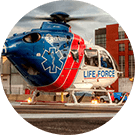Katie Campbell worked for years as an Emergency Medical Technician in Arkansas. Thankfully, she knows the signs and symptoms of a stroke.
On February 7, 2019, Katie and her husband, Randy Wells, were out to dinner when Katie noticed her husband’s mouth was drooping a little on one side.
“Because of my training, I knew what was happening,” she said. “I took him home and took his blood pressure – it was 220/160. I called 911 and the ambulance got here and they took his pressure. It had gone up and they said, ‘You have to go now.’”
Because of the Arkansas SAVES program, Air Evac Lifeteam was early activated. Arkansas SAVES stands for Arkansas Stroke Assistance through Virtual Emergency Support. The program began on November 1, 2008 and has grown to 48 partnering sites throughout the state. Vascular neurologists share call to provide 24/7 consult coverage. Each of the partnering sites is equipped with telemedicine technology, training for personnel, support for dedicated telestroke coordinator and ongoing continuing education.
The Morrilton, AR, crew flew to the small community of Fairfield Bay. The EMS crew drove Randy to the helipad and Katie spoke with the crew.
“I asked point-blank, ‘Where do we want to go?’”
Because his symptoms began two hours before he was flown, the crew elected to transport Randy to the closest medical facility that could administer TPA – a clot-busting drug.
Randy, a United States Air Force veteran, had flown in helicopters before – but not as a patient.
“This crew is a great bunch of guys,” he said. “They actually waited until my wife got there before they left the hospital.”
Conway Regional Medical Center is a participant in the Arkansas SAVES Program, and the doctors there were able to talk with a vascular neurologist, who prescribed the administration of the TPA.
“He received the TPA and it worked,” Katie said. “When I walked in, they were already giving him the medicine.”
“I still have a little slurred speech, but the droop in my mouth is slowly going away,” Randy said. “My wife caught the stroke symptoms in time. She’s a peach.”
Randy and Katie are members of the AirMedCare Network.
“We’ve been Air Evac members since 2010,” Randy said. “I tell everyone they need to get an Air Evac membership. I had no idea that was going to happen to me. Everything was hunky-dory and all of the sudden, bang!”
Frequently Asked Questions:
If an AirMedCare Network Provider does not transport you, you will be responsible for payment. Our membership program only covers transports provided by our affiliates.
There is no limit to the number of transports a member may take in a year. Each transport is handled the same way and must be an emergent or time-sensitive transport as determined by a physician (or other appropriate provider) or first responder unaffiliated with AMCN.
With an AirMedCare Network membership, any person or persons who reside under one (residential) roof are covered. In the event we have a member who lives in a duplex or apartment complex, we designate the primary member’s residence/address— that is considered the “one roof”. Undergraduate college students can be covered under their parent’s membership as well as anyone previously residing in the household who is then moved to a permanent care facility.

How Air Ambulances Can Help Reduce Emergency Room Wait Times
Patient experience in healthcare has been a hot topic for the past 20 years. Studies show that when patients are happier with their care, they

Holiday Gifting for the Family That Has Everything: Unique Gifts They’ll Truly Appreciate
Finding the perfect gift for a family that seems to have it all can feel nearly impossible. They already own the latest gadgets, their home

A flight nurse’s courage: How one hero stepped up when it mattered most
Across the country, emergency medical professionals are trained to respond at a moment’s notice®. But sometimes circumstances make a difficult situation even more challenging —




